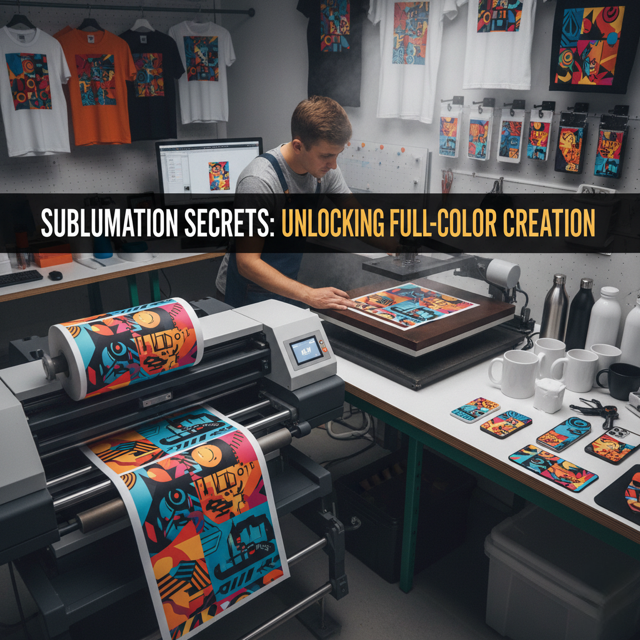
DISCOUNTED EDUCATION PRICING! CALL 1-877-891-8411. We Gladly Accept School Purchase Orders!

Sublimation printing has rapidly grown into one of the most reliable, versatile, and cost-effective printing methods available today. From schools creating classroom visuals to entrepreneurs launching custom T-shirt businesses, sublimation is making professional-quality printing accessible to everyone.
But many people still have questions: What exactly is sublimation? How does it work? What products can you create? And is it worth the investment compared to other printing techniques?
This guide answers all of those questions—and more—so that whether you’re a teacher, business owner, or creative, you’ll know exactly how sublimation printing can work for you.
Question: What does sublimation mean in printing?
Answer: Sublimation printing is a digital printing process where heat and pressure turn solid ink into gas, which then bonds directly with polyester fibers or polymer-coated surfaces. Unlike traditional printing, which layers ink on top of the material, sublimation embeds the design into the material itself.
The result is long-lasting, full-color, photo-quality designs that won’t peel, crack, or wash away. Think of it as a permanent dye infusion rather than surface decoration.
The sublimation process has four essential elements:
Step-by-Step Workflow:
This process ensures crisp, full-color images that remain vibrant even after years of use.
Sublimation is not universally compatible with all surfaces. It thrives on certain materials:
Question: Can sublimation work on cotton?
Answer: Pure cotton doesn’t work well with sublimation because it lacks polyester fibers. However, you can sublimate onto cotton using polyester sprays or heat-transfer vinyl as a base layer. The results won’t be as vibrant or long-lasting as true polyester.
One of the biggest advantages of sublimation is its versatility. Businesses, schools, and individuals use it to produce:
Question: Why is sublimation popular for schools?
Answer: Schools benefit from sublimation because it allows staff to create visuals on demand—like anchor charts, STEM posters, or SEL (social-emotional learning) walls—without outsourcing. It also enables cost-effective spirit wear, awards, and fundraiser merchandise.
To understand sublimation’s strengths, it’s useful to compare it with other printing methods.
| Method | Best For | Pros | Cons |
|---|---|---|---|
| Sublimation | Polyester fabrics, coated products | Vibrant, permanent, soft feel, full-color | Limited to light-colored polyester or coated items |
| Screen Printing | Cotton, bulk runs | Great for dark fabrics, durable, economical in volume | Limited colors, setup costs |
| Vinyl Heat Transfer | Custom logos, numbers | Works on cotton, good for small details | Heavy feel, peels over time |
| DTG (Direct-to-Garment) | Cotton, full-color designs | Works on dark cotton, photorealistic | Less durable than sublimation, higher ink cost |
Question: Is sublimation always better?
Answer: Not always. For dark cotton shirts or huge bulk orders, screen printing may be more efficient. But for full-color, small runs, or polyester fabrics, sublimation usually wins.
While sublimation is powerful, it has some limitations:
Pro Tip: Many businesses start small with a desktop sublimation printer and mug press, then scale up to wide-format printers for posters and apparel.
Schools and districts are adopting sublimation printers to cut costs and bring creativity into classrooms.
Use Cases:
Instead of outsourcing, schools can produce what they need instantly—saving time and budget.
Imagine a local entrepreneur who wants to launch a side hustle selling personalized mugs and shirts online. Sublimation is perfect because:
Many Etsy shops and print-on-demand businesses rely heavily on sublimation for exactly this reason.
Q: How durable is sublimation printing?
A: Sublimation prints on fabric last as long as the fabric itself. On hard goods, prints are scratch-resistant and fade-resistant for years.
Q: Is sublimation expensive?
A: Entry-level setups are affordable, but professional-grade sublimation printers and large heat presses require investment. However, the low per-item cost makes it profitable.
Q: Can I sublimate on dark shirts?
A: Direct sublimation doesn’t work on dark shirts. However, you can use white sublimation vinyl as a base layer for designs.
Q: What’s the difference between sublimation and heat transfer?
A: Heat transfer layers ink or vinyl on top of fabric, which can peel or crack. Sublimation infuses ink into fibers, making it permanent and soft to the touch.
Q: Is sublimation eco-friendly?
A: Compared to traditional dyeing or screen printing, sublimation uses less water and creates less waste, making it a greener choice.
The sublimation market is projected to grow steadily, driven by customization trends. Advances include:
Schools, e-commerce stores, and promotional companies will continue to benefit from sublimation’s flexibility.
Sublimation printing offers incredible benefits:
Sublimation printing is widely regarded as one of the most effective and versatile printing methods available today, particularly when it comes to achieving exceptional durability, intricate detail, and flexibility on a variety of surfaces. This technique is especially well-suited for polyester fabrics and coated products, where it delivers vibrant, long-lasting results that maintain their quality over time. Unlike traditional poster printers, using heat to transfer dye directly into the material, sublimation ensures that designs are not only visually striking but also resistant to fading, cracking, or peeling, making it an ideal choice for applications requiring both aesthetic precision and robust performance. Whether for custom apparel, promotional items, or specialized coated substrates, sublimation printing offers unmatched reliability and adaptability for a wide range of creative and functional needs.